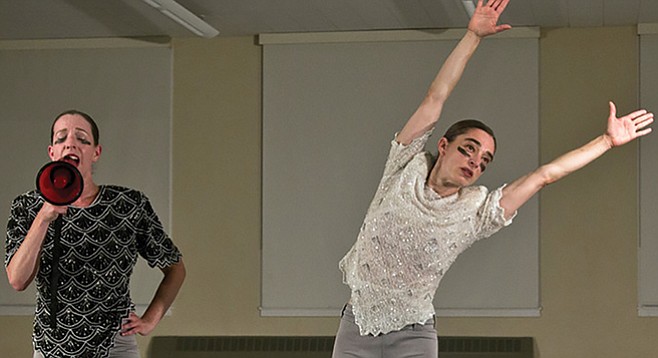 Facebook
Facebook
 X
X
 Instagram
Instagram
 TikTok
TikTok
 Youtube
Youtube

Last month, New York–based dance troupe, Monica Bill Barnes & Company put on a single performance of Every Night’s a Show Night, a self-styled work-in-progress, at San Diego Dance Theatre. To the tune of excellent American music — mostly old-school country, with a smattering of lounge and soul — Barnes and her longtime partner, Anna Bass, worked a sports theme for all it’s worth, pausing periodically to chastise the audience with a bullhorn, scowl like Ronda Rowsey, and incite the Wave.
The audience ate it up, clapping and laughing at Vaudeville pratfalls and deft athleticism alike. In part, it seems like the audience responded to the near absence of the fourth wall in the production. Barnes and Bass played directly to the crowd with a kind of Burning Man circus intensity, which made many people feel like this was a show you could get into and enjoy, rather than a cerebral exploration of vague concepts of movement, or some other conceit one might expect from modern dance.
But, at some point between aloofly pondering life at the far end of the stage and sitting down in empty seats for a quick chat with audience members, breaking the fourth wall stops bringing the audience into the show, and starts taking the performers out of it. More important critics than I (read, “actual critics”) have called shenanigans on Barnes’s choreography in New York. One copyeditor/online dance columnist for the New Yorker called Barnes out as a hipster tryhard “desperate to entertain.” The New York Times said Barnes’ work fell prey to a “ruinous...cutesy-pie effect.”
Ouch.
At least the New Yorker admits that audiences love the performances, a fact which held true here in San Diego, and which seems to be the case with Barnes’s work elsewhere. National Public Radio’s Ira Glass likes Barnes’s work enough that he brought her on the road with This American Life.
This critical/popular disconnect hardly belongs to dance alone. Critics (withstanding the San Diego Reader’s Matthew Lickona) panned the recent Warcraft movie as trite entertainment that panders to fans. Audiences love it.
Who’s right?
I’d sincerely like to know, so please, as an audience member, write in, tell us: do you feel pandered to when a performer plays to you forthwith, or does it delight and inspire you to standing applause?
(See what I did there?)


Last month, New York–based dance troupe, Monica Bill Barnes & Company put on a single performance of Every Night’s a Show Night, a self-styled work-in-progress, at San Diego Dance Theatre. To the tune of excellent American music — mostly old-school country, with a smattering of lounge and soul — Barnes and her longtime partner, Anna Bass, worked a sports theme for all it’s worth, pausing periodically to chastise the audience with a bullhorn, scowl like Ronda Rowsey, and incite the Wave.
The audience ate it up, clapping and laughing at Vaudeville pratfalls and deft athleticism alike. In part, it seems like the audience responded to the near absence of the fourth wall in the production. Barnes and Bass played directly to the crowd with a kind of Burning Man circus intensity, which made many people feel like this was a show you could get into and enjoy, rather than a cerebral exploration of vague concepts of movement, or some other conceit one might expect from modern dance.
But, at some point between aloofly pondering life at the far end of the stage and sitting down in empty seats for a quick chat with audience members, breaking the fourth wall stops bringing the audience into the show, and starts taking the performers out of it. More important critics than I (read, “actual critics”) have called shenanigans on Barnes’s choreography in New York. One copyeditor/online dance columnist for the New Yorker called Barnes out as a hipster tryhard “desperate to entertain.” The New York Times said Barnes’ work fell prey to a “ruinous...cutesy-pie effect.”
Ouch.
At least the New Yorker admits that audiences love the performances, a fact which held true here in San Diego, and which seems to be the case with Barnes’s work elsewhere. National Public Radio’s Ira Glass likes Barnes’s work enough that he brought her on the road with This American Life.
This critical/popular disconnect hardly belongs to dance alone. Critics (withstanding the San Diego Reader’s Matthew Lickona) panned the recent Warcraft movie as trite entertainment that panders to fans. Audiences love it.
Who’s right?
I’d sincerely like to know, so please, as an audience member, write in, tell us: do you feel pandered to when a performer plays to you forthwith, or does it delight and inspire you to standing applause?
(See what I did there?)
Comments